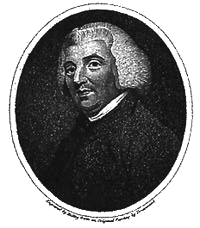Born in July 1743, in Peterborough, England, William Paley trained for the
Anglican priesthood, graduating from Christ's College, Cambridge in 1763.
He was appointed a fellow and tutor of his college in 1766, and rose
through the ranks of the Anglican Church. He died on May 25, 1805.
Paley wrote several books on philosophy and Christianity, which proved
extremely influential. His 1794 book A View of the Evidence of
Christianity was required reading at Cambridge University until the
20th century. His most influential contribution to biological thought,
however, was his book Natural Theology: or, Evidences of the Existence
and Attributes of the Deity, Collected from the Appearances of Nature,
first published in 1802. In this book, Paley laid out a full exposition of
natural theology, the belief that the nature of God could be understood by
reference to His creation, the natural world. He introduced one of the most
famous metaphors in the philosophy of science, the image of the
watchmaker:
. . . when we come to inspect the watch, we perceive. . . that its several
parts are framed and put together for a purpose, e.g. that they are so
formed and adjusted as to produce motion, and that motion so regulated as
to point out the hour of the day; that if the different parts had been
differently shaped from what they are, or placed after any other manner
or in any other order than that in which they are placed, either no motion
at all would have been carried on in the machine, or none which would
have answered the use that is now served by it. . . .
the inference we think is inevitable, that the watch must have
had a maker -- that there must have existed, at some time and at some
place or other, an artificer or artificers who formed it for the purpose
which we find it actually to answer, who comprehended its construction
and designed its use.
Living organisms, Paley argued, are even more complicated than watches,
"in a degree which exceeds all computation." How else to account for the
often amazing adaptations of animals and plants? Only an intelligent
Designer could have created them, just as only an intelligent watchmaker
can make a watch:
The marks of design are too strong to be got over. Design must have had a
designer. That designer must have been a person. That person is GOD.
And, as Paley went on to argue,
if God had taken such care in designing even the most humble and
insignificant organisms, how much more must God care for humanity!
The hinges in the wings of an earwig, and the joints of its antennae, are as
highly wrought, as if the Creator had nothing else to finish. We see no signs
of dimunition of care by multiplicity of objects, or of distraction of thought
by variety. We have no reason to fear, therefore, our being forgotten, or
overlooked, or neglected.
Paley's arguments go back to authors such as John
Ray, and have had a long intellectual history, surviving to the present
day in many a piece of creationist rhetoric. Yet Charles Darwin, while
himself a student at Christ's College of Cambridge University, not only had
to read Paley, but was deeply impressed with Paley's arguments, as the quote
at the top of this page shows. Even though Paley's concept of God as
a designer is very different from Darwin's theory of natural selection,
Darwin took from his reading of Paley a belief in adaptation -- that
organisms are somehow fit for the environments in which they live, that
their structure reflects the functions they perform throughout their lives.
Where natural theology ran into trouble was in explaining the many cases of
apparent pain, waste, and cruelty in the living world: why would a benevolent
Designer have made cats play with mice before killing them, or parasites that
eat their hosts from the inside? Paley struggled to reconcile the apparent
cruelty and indifference of nature with his belief in a good God, and finally
concluded that the joys of life simply outweighed its sorrows.
Where Darwin departed from Paley was in his concept of natural selection
as a process that could produce adaptation and design without the
all-encompassing intervention of a benevolent Designer.




